Official Name
Chişinău (pronounced 'kishi-now', phon: ki:ʃi:naʊ) is the Moldovan (ie Romanian) name of the town. The Russian name is Кишинев (Kishinev), the Ukrainian name is Кишинів (Kyschyniv). The most common spelling in the English world seems to be Kishinev. There are numerous other spellings: Kischinow, Kishinov, Кишинэу, Kishinëw, Kischinew and so on and so forth. In this page, the name 'Chisinau' is used, because this is what is most often used in the town itself, too. The origin of the name is not quite clear, but there are some theory. It's probably deriving from a Turkic language and might mean "where the sheeps graze", "fountain" or "monastery village".
Location

| ||
| Chişinău |
Chisinau is conveniently located in the middle of the Republic of Moldova. The town stretches in a valley along the small river Bâc (Byk) from the north-west to the south-east. The river finally flows into the Nistru (Dniestr). North-west of Chisinau, the river feeds into a large water reservoir.
Population
There are two administrative districts with the same name - Judetul Chişinău is the metropolitan area surrounding the town and has 382,000 inhabitants. The town itself incl. the suburbs is called Chişinău Oraş and has 780,000 inhabitants. Chisinau itself has 662,000 inhabitants (all figures as of 2003). Thus, Chisinau is by far the largest town in the country.
Orientation
Large parts of Chisinau were heavily damaged during the Second World War, so it needed to be remodelled after the war. Socialist urban development rules were applied, including a strictly geometric grid of streets and a lot of space. The city centre therefore is very spacious. The Găra (train station) is located in the the south-east of the centre inside the valley of river Byk. From there, Negruzzi blvd leads to the main road called Blvd. Ştefan cel Mare (Stephen the Great), which is on a southeast-northwest axis crossing the entire city centre. There's a lot of green along the main road and several parks in the centre as well as in the south and west.
The economic heart of the town is the bustling central market and bus station and it's vicinity. From there it's only one hundred metres or so to the main boulevard. The broad streets as well as the green make for a pleasant walk. When having a look at the architecture, you will soon notice where you are: in a former Soviet Union model city. Which isn't necessarily a bad thing.
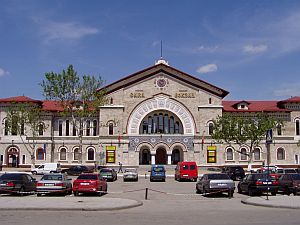
| ||
| The spotless clean, fine train station of Chisinau |
History
The place name was first mentioned in the year 1352, but it appears to be that the town itself was only founded in 1436. From 1812 to 1918, after the occupation by the Russian Tsar, Chisinau became the capital of the region. After 1918, Bessarabia (present-day Moldova, the part west of the Dniestr) united with →Romania, making →Iaşi in Eastern Romania the capital. After 1940, Chisinau became the capital again. Since 1944, it was the capital of the Socialist Soviet Republic of Moldova. As already mentioned above, the town and its citizens suffered a lot during the World War II. The town was virtually levelled by heavy attacks.
Once, Chisinau was a very important centre of Jewish culture. There were Jewish schools, almost 70 synagogues and an estimated 50,000 Jews. In the year 1903, a massive pogrom left 49 Jews dead. In 1941, further pogroms, initiated by the Nazis, took place. Countless Jews were killed or deported. Nowadays, Jewish culture is slowly coming back, but the poor economic condition won't help the situation.
Getting there / transportation
Naturally, Chisinau is not just the capital but also the main transport hub with several direct flights to several destinations in Europe. The international airport is only a few kilometres away close to the suburbs in the south. One bus and several marshrutkas (microbuses) run between the city centre and the airport.
For detailed information on train and bus connections to and from Chisinau see the chapter about →Getting to Moldova. Most of the buses arrive at the central Autogăra (bus station) next to the large market in the centre. From there it's only a few metres to the main road. Traffic has increased, and so the bus station is characterized by ... complete chaos. That's why a new bus station was built: Autogăra Sud-Vest, which is far away from the city centre near the south-west suburb of Codru on the top of a hill. Marshrutka No 192 runs between the two bus stations, which takes more than 15 minutes. The fare is 3 Lei (€ 0.2). All buses running south to →Comrat, Cahul etc depart from the Sud-Vest station.
All the major sights in Chisinau are within walking distance. But there are also countless buses and marshrutkas running up and down the main road.
The first impression depends on where you are going to arrive. The first thing you will think when you arrive by bus is "What a chaos!" The burstling, hectic market and the bus station, which is way to small for all the buses, are probably the busiest place in the country. Arriving by train leaves another impression: The beautiful, modern train station is spotless clean and the digital departure boards are the latest rage. The entrance is guarded by doorkeepers, asking everyone who wants to step in about one's intention. Of course not in English. Well, the station is clean and it's probably supposed to stay clean. The same can be said about the façade and the small park in front of the station.
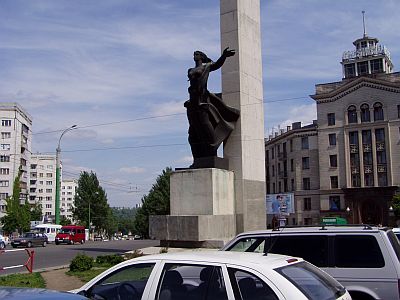
| ||
| Genuine socialist atmosphere at Liberation Square |
When you walk from the train station straight ahead and then right onto the first road, you well soon get to Piaţa Negruzzi (Piaţa = square), which is a large junction dominated by the not very attractive, but large and expensive Hotel Cosmos and a huge concrete building without any windows. From there, walk left onto blvd. Negruzzi and up the long slope, and you will get to Piaţa Libertăţii (Liberation Square) with a large monument in the middle. The monument as well as the surrounding buildings are fine examples of the typical socialist architecture from the 1950ies.
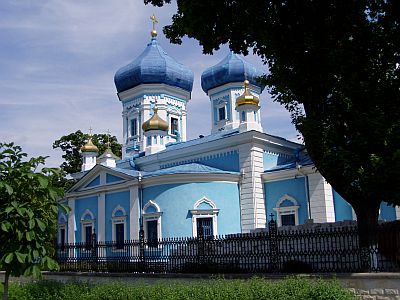
| ||
| The characteristic St Tiron Cathedral in Chisinau |
Not far from Liberation square in the south-west there's a surprisingly colourful spot among all the grey concrete buildings. It's the almost penetrating blue Catedrala Sf. Tiron (St Tiron Cathedral), which was under reconstruction in 2004 (the reconstruction should have been completed by the time you read this). Somehow it resembles the St Michael Monastery in →Kyiv, which is certainly no coincidence.
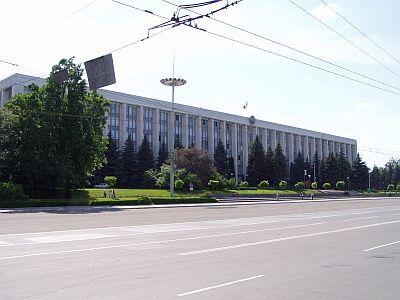
| ||
| Government house of the Republic of Moldova |
Almost all important buildings of Chisinau concentrate along or at least close to the main road Blvd. Ştefan cel Mare (Stephen the Great blvd). Among those buildings are some oversized administration buildings. The most important one is the Government House of the Republic of Moldova, which is more than 1 km away from the train station. Opposite the government house, there's the Arc de Triomphe - a miniature version of the Parisienne original built in the year 1846. On the right of the Government House there's the beautiful Parcul Ştefan cel Mare. The entrance to the small park features a monument dedicated to Stephen the Great. Behind the Government House, you will find the National Art Museum, the National History Museum, the National Library and many modern cafés and restaurants.
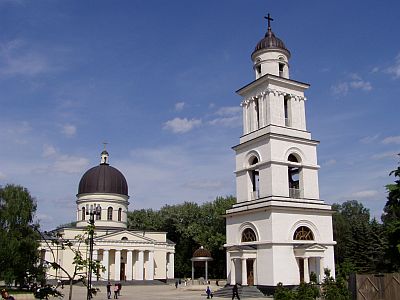
| ||
| The small but fine Orthodox Cathedral |
Right behind the Arc de Triomphe sprawls Parcul Catedralei (Cathedral Park), dominated by the large, white belfry and the Catedrala din Chişinău (Cathedral of Chisinau) - a beautiful church built in the year 1836. It's nothing less than the main cathedral of the Orthodox church in Moldova. The bells inside the belfry were made of Turkish cannons - two dozen years after the liberation from the Ottoman yoke. The interior of the cathedral is very beautiful, too.
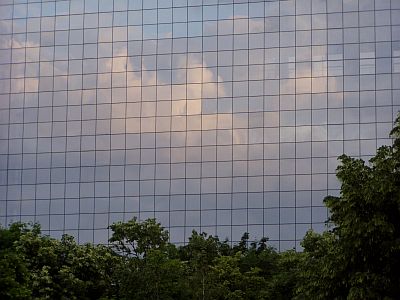
| ||
| Modern bank building in the town centre |
There are many modern buildings in the city centre - most of them built by banks and mobile phone companies. Talking about telephones: Even in the smallest village you can see people walking around with mobile phones. Despite the poverty, it seems to be big business - the companies build many new offices and shops. Everything might go wrong, but telecommunication works. The glass façade of the modern building on the picture above stands in sharp contrast to the market, where the people sell vegetables and fruits and Chinese clothes etc for a handful of bani.
Some 10 km north of the capital there's the 'wine town' of Cricova. The underground of Cricova is like a Swiss cheese - the wine cellars below the town are around 60 km long; many of the tunnels are accessible by car. Here, millions of bottles of wine and champagne are stored. It's possible to visit the cellars. However, it's only possible in groups and has to be booked in advance - for individual travelers almost impossible. As far as I've heard, the tour costs more than 25 USD per person.
Private accommodations or hotels. There are several huge hotels built during Soviet times - most of them are rather pricey. Hotel Meridan is conveniently located next to the market and the bus station. Half of the rooms are occupied by offices and doctors, so you'll have to pass the dentist and the gynaecologist before you get to your room. In front of the building, there's a roofed market with hundreds of street vendors, making it hard to find the proper entrance (it's the one on the right side). Staff will first show you the most expensive room, so you'll have to ask for the others. A clean double room with a balcony, cable TV, bathroom (hot water!!!) etc costs 400 Lei (ie € 14 Euro per person). There's no hotel restaurant. And you won't need the TV - watching the hectic life at the market and bus station is interesting enough. Here's the address: Str. Tighina 42, Tel.: (02)-270 620.
There are many restaurants in town - some of them are good, some are bad. Therefore some hints: Cafenea-Pizza "Orange" (Blvd. Ştefan cel Mare) serves Moldovan and Italian food in a modern atmosphere. The quality is good. Main dishes cost between 15 and 30 Lei (€ 1- 2 ). The service is remarkably good - and fast.
La Bunel (Str. Eminescu 50) has a large menu and very friendly staff. In summer it's possible to sit outside in the courtyard. Mains are between 15 und 75 Lei (€ 1-5), most dishes are Moldovan or Jewish. The quality is okay but it could be better.
Facing Blvd. Negruzzi, there's the modern Beer House specializing in Belgium beer (unfortunately) and good quality, mostly Moldovan food. Main dishes are between 20 and 80 Lei. Quite upmarket, and the service is just perfect.
The dark Restaurant Chisinau at Liberation Square is like a step back in time: This was an upmarket restaurant in Soviet times, and absolutely nothing has changed: The atmosphere is genuine. Athough there are almost no customers, an old school porter takes care of the jackets. Many items written on the menu are not available (as I said - nothing has changed). The food is okay, and staff is very patient and friendly. Prices are middle of the range, main dishes are between 15 and 50 Lei.
- www.chisinau.md Official but not very informative website of Chisinau. English version didn't work but this might have changed.
- sauseschritt.twoday.net/topics/chisinau Very interesting article about Chisinau in German and English.
- www.galenfrysinger.com Some images from Chisinau with a short explanation in English.
Do you have or do you know a good website about Chisinau? Don't hesitate, let me know! After checking it, I would love to add it to the link list. You can submit a link by using the →contact form. Note that commercial websites will be treated differently.
Marisha wrote:
Great site!
My friends and I are offering budget accommodation in Chisinau, Tiraspol and at the countryside to travelers. We've got beds/private rooms from 10 Euro per night. We can also arrange tours around Moldova and Transdniestr. More about accommodation and our services in Moldova on http://www.marisha.net.
Also, we've got a forum about Moldova in English. Our members are coming from Moldova and Transdniestr, but also expats who live and work in Moldova. http://www.englishmoldova.com
Regards,
Marisha
Posted by Marisha on November 24, 2008 00:28
©2024 Europe-East.com

 Albania
Albania Moldova
Moldova